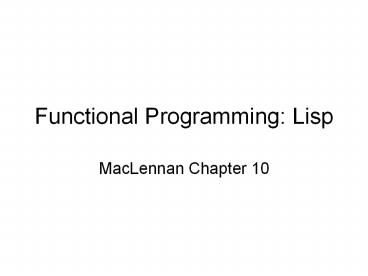Functional Programming: Lisp - PowerPoint PPT Presentation
1 / 19
Title:
Functional Programming: Lisp
Description:
(plus (car a) (plus-red (cdr a)) )) ) (plus-red (1 2 3 4 5)) 15. 7. Mapping: mapping a list into another list of the same size (defun add1-map (a) (if (null a) ... – PowerPoint PPT presentation
Number of Views:37
Avg rating:3.0/5.0
Title: Functional Programming: Lisp
1
Functional Programming Lisp
- MacLennan Chapter 10
2
Control Structures
- Atoms are the only primitives since they are the
only constructs that do not alter the control
flow. - Literals (represent themselves)
- Numbers
- Quoted atoms
- lists
- Unquoted atoms are bound to
- Functions (if they have expr property)
- Data values (if they have apval property)
- Control-structure constructors
- Conditional expression
- Recursive application of a function to its
arguments
3
- In LISP we have conditional expression.
- While in Fortran and Pascal we have to drop from
expression level to instruction level to make a
choice.
4
The logical connectives are evaluated
conditionally
- (or x y) (if x t y)
- (or (eq (car L) key) (null L) )
- What happen if L is null?
- (or (null L) (eq(car L) key) )
- Does this work?
- (if (null L) t (eq (car L) key))
5
Iteration is done by recursive
- (defun getprop (p x)
- (if (eq (car x) p)
- ( cadr x)
- (getprop p (cddr x)) ))
6
- Reduction reducing a list to one value
- (defun plus-red (a)
- (if (null a)
- 0
- (plus (car a) (plus-red (cdr a)) )) )
- (plus-red (1 2 3 4 5))
- gtgt 15
7
- Mapping mapping a list into another list of the
same size - (defun add1-map (a)
- (if (null a)
- nil
- (cons (add1 (car a)) (add1-map (cdr a))
)) ) - (add1-map (1 9 8 4))
- gtgt(2 10 9 5)
8
- Filtering forming a sublist containing all the
elements that satisfy some property - (defun minus-fil (a)
- (cond ((null a) nil)
- (( minusp (car a))
- (cons (car a) minusp-fil (cdr
a)) )) - (t (minusp-fil (cdr a)) )) )
9
- Some thing like Cartesian product , which needs
two nested loop - For example
- (All-pairs (a b c) (x y z))
- gtgt((a x) (a y) (a z) (b x) (b y) (b z) (c x) (c
y) (c z)) - We use distl (distribute from left)
- (distl b (x y z))
- gtgt((b x) (b y) (b z))
10
- (defun all-pairs (M N)
- (if (null M)
- nil
- (append (distl (car M) N)
- (all-pairs (cdr M) N)) ))
- (defun distl (x N)
- (if (null N)
- nil
- (cons (list x) (car N))
- (distl x (cdr N)) )) )
- (the list function makes a list out of its
argument)
11
- Recursion for Hierarchical structures
- (defun equal (x y)
- ( or (and (atom x) (atom y) (eq x y))
- (and (not (atom x)) (not (atom y))
- (equal (car x) (car y))
- (equal (cdr x) (cdr y)) )) )
12
- Recursion and Iteration are theoretically
equivalent
13
Functional arguments allow abstraction
- mapcar a function which applies a given function
to each element of a list and returns a list of
the results. - (defun mapcar (f x)
- (if (null x)
- nil
- (cons (f (car x)) (mapcar f (cdr x)) ))
) - (mapcar add1 (1 9 8 4))
- gtgt (2 10 9 5)
- (mapcar zerop (4 7 0 3 -2 0 1))
- gtgt (nil nil t nil nil t nil)
- (mapcar not (mapcar zerop (4 7 0 3 -2 0 1)))
- gtgt (t t nil t t nil t)
14
Functional arguments allow programs to be combined
- They simplify the combination of already
implemented programs.
15
Lambda expressions are anonymous functions
- Instead of defining a name for a function
- (defun twotimes (x) (times x 2)
- (mapcar twotimes L)
- We may write
- (mapcar (lambda (x) (times x 2)) L)
16
Name Structures
- The primitive name structures are the individual
bindings of names (atoms) to their values. - Bindings are established through
- Property lists
- By pseudo-functions
- set (like declaring a variable)
- Defun (like declaring a procedure)
- Actual-formal correspondence
17
- Application binds Formals to Actuals
18
- Temporary bindings are a simple, syntactic
extension (with let )
19
- Dynamics scoping is the constructor
- Dynamic scoping complicates functional arguments

